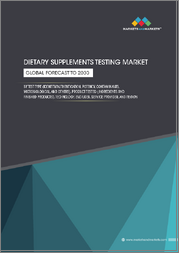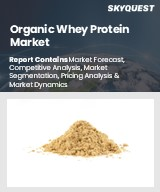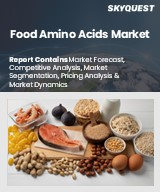
|
시장보고서
상품코드
1819946
프로바이오틱스 식이보충제 시장 보고서 : 형태, 유통 채널, 용도, 지역별(2025-2033년)Probiotic Dietary Supplement Market Report by Form, Distribution Channel, Application, and Region 2025-2033 |
||||||
세계 프로바이오틱스 식이보충제 시장 규모는 2024년 78억 달러에 달했습니다. IMARC Group은 2033년까지 시장 규모가 129억 달러에 달하고, 2025-2033년 5.8%의 연평균 성장률(CAGR)을 보일 것으로 예측했습니다. 건강한 장을 유지하려는 개인들의 인식이 높아지면서 시장을 주도하고 있습니다.
프로바이오틱스 식이보충제 시장 동향 :
건강 보조 식품과의 통합 증가
시장을 자극하는 주요 요인 중 하나는 프로바이오틱스를 미네랄, 비타민, 허브 추출물과 같은 다른 영양 보충제와 결합하여 종합 건강 보조 식품으로 만드는 수요가 확대되고 있다는 점입니다. 예를 들어, 2024년 4월, 바이브런트 헬스(Vibrant Health)는 품질 저하 없이 웰빙 루틴을 단순화하도록 설계된 하루 3알의 종합비타민 + 오메가3 + 프로바이오틱스 보충제인 트릴로지(Trilogy)를 출시했습니다. 이 종합비타민에는 비타민 B12, A, C, D3, E와 마그네슘, 셀레늄, 아연 등 필수 미네랄이 함유되어 있습니다. 마찬가지로 2024년 4월, 사노피 소비자 건강관리(CHC)는 영국에서 프로바이오틱스 기반 장 건강 보조제를 출시했습니다. 이것이 프로바이오틱스 식이보충제 시장 점유율을 확대하고 있습니다.
제품 혁신 증가
각 업체들은 새로운 프로바이오틱스 균주 및 전달 방법을 개발하고 있으며, 이는 큰 성장 촉진요인으로 작용하고 있습니다. 프로바이오틱스는 기존의 캡슐뿐만 아니라 분말, 젤리, 음료, 심지어 스킨케어 제품까지 다양한 형태로 출시되고 있습니다. 이렇게 다양화되면서 소비자의 취향도 다양해졌고, 프로바이오틱스를 라이프스타일에 쉽게 접목할 수 있게 되었습니다. 예를 들어, 2024년 6월 이스라엘의 농식품 스타트업 원더베지스는 세계 최초로 프로바이오틱스 박테리아가 식물 조직에 침투해 엔도파이트로 작용할 수 있도록 하는 기술을 이용해 세계 최초의 프로바이오틱스 신선식품을 출시했습니다. 이는 프로바이오틱스 식이보충제 시장 전망에 긍정적인 영향을 미치고 있습니다.
개인 맞춤형 영양에 대한 수요 증가
개인의 건강 프로파일에 따라 맞춤형 프로바이오틱스 보충제를 제공하는 새로운 트렌드가 시장에 활력을 불어넣고 있습니다. 이 외에도 마이크로바이옴 분석, 유전자 검사, 생활습관 평가 등의 데이터를 활용하여 맞춤형 솔루션을 통해 특정 건강 요구 사항을 보다 효과적으로 해결하는 것을 목표로 하고 있습니다. 예를 들어, 영양 과학 분야 제공 업체 중 하나인 Nestle Health Science는 2024년 6월 glp-1nutrition.com을 발표했습니다. glp-1nutrition.com은 특히 GLP-1 약물을 사용하는 개인의 체중 관리 여정을 지원하기 위해 고안된 웹 플랫폼입니다. 이로 인해 프로바이오틱스 식이보충제 시장에 대한 수요가 증가하고 있습니다.
목차
제1장 서문
제2장 조사 범위와 조사 방법
- 조사 목적
- 이해관계자
- 데이터 소스
- 1차 정보
- 2차 정보
- 시장 추정
- 보텀업 접근
- 톱다운 접근
- 조사 방법
제3장 주요 요약
제4장 서론
제5장 세계의 프로바이오틱스 식이보충제 시장
- 시장 개요
- 시장 실적
- COVID-19의 영향
- 시장 예측
제6장 시장 분석 : 형태별
- 파우더 스틱 팩
- 캡슐
- 정제
- 프로바이오틱스 드롭
제7장 시장 분석 : 유통 채널별
- 슈퍼마켓 및 하이퍼마켓
- 약국 및 건강식품점
- 온라인 스토어
- 기타
제8장 시장 분석 : 용도별
- 식품 보조제
- 영양 보조제
- 특수 영양소
- 유아용 조제분유
- 기타
제9장 시장 분석 : 지역별
- 북미
- 미국
- 캐나다
- 아시아태평양
- 중국
- 일본
- 인도
- 한국
- 호주
- 인도네시아
- 기타
- 유럽
- 독일
- 프랑스
- 영국
- 이탈리아
- 스페인
- 러시아
- 기타
- 라틴아메리카
- 브라질
- 멕시코
- 기타
- 중동 및 아프리카
제10장 SWOT 분석
제11장 밸류체인 분석
제12장 Porter의 Five Forces 분석
제13장 가격 분석
제14장 경쟁 구도
- 시장 구조
- 주요 기업
- 주요 기업 개요
- BioGaia
- Chr. Hansen Holding A/S
- Custom Probiotics Inc.
- Dietary Pro Labs
- Koninklijke DSM N.V.
- NutraScience Labs(Twinlab Consolidated Holdings Inc.)
- Probi USA Inc.(Symrise AG)
- ProbioFerm
- Protexin(Archer-Daniels-Midland Company)
- Reckitt Benckiser Group plc
- Vitakem Nutraceuticals Inc.
The global probiotic dietary supplement market size reached USD 7.8 Billion in 2024. Looking forward, IMARC Group expects the market to reach USD 12.9 Billion by 2033, exhibiting a growth rate (CAGR) of 5.8% during 2025-2033. The growing awareness among individuals towards maintaining a healthy gut is primarily driving the market.
Probiotic Dietary Supplement Market Trends:
Increasing Integration with Nutraceuticals
One of the key factors stimulating the market is the widespread demand for probiotics combined with other nutraceuticals, such as minerals, vitamins, herbal extracts, etc., to create comprehensive health supplements. For instance, in April 2024, Vibrant Health released Trilogy, a daily 3-in-1 multivitamin plus omega-3 and probiotic supplement designed to simplify wellness routines without compromising on quality. The multivitamin provides vitamins B12, A, C, D3, E and essential minerals like magnesium, selenium, zinc, etc. Similarly, in April 2024, Sanofi Consumer Healthcare introduced a probiotic-based gut health supplement in the UK. This is expanding the probiotic dietary supplement market share.
Rising Product Innovations
Companies are developing new probiotic strains and delivery methods, which is a significant growth-inducing factor. Beyond traditional capsules, probiotics are now found in powders, gummies, beverages, and even skincare products. This diversification caters to different consumer preferences, thereby making it easier for people to incorporate probiotics into their lifestyles. For instance, in June 2024, Israeli agrifood tech startup Wonder Veggies launched the world's first probiotic fresh produce by using technology that enables probiotic bacteria to penetrate plant tissue and serve as endophytes. This is positively influencing the probiotic dietary supplement market outlook.
Growing Demand for Personalized Nutrition
The emerging trend of offering tailored probiotic supplements based on individual health profiles is stimulating the market. Apart from this, adopting data from microbiome analysis, genetic tests, and lifestyle assessments, these customized solutions aim to address specific health needs more effectively. For example, in June 2024, Nestle Health Science, one of the providers in nutritional science, introduced glp-1nutrition.com, a web platform designed to support individuals on their weight management journey, particularly those using GLP-1 medications. This is escalating the probiotic dietary supplement market demand.
Global Probiotic Dietary Supplement Industry Segmentation:
Breakup by Form:
- Powder Stick Pack
- Capsule
- Tablet
- Probiotic Drops
Capsule currently exhibits a clear dominance in the market
Probiotic dietary supplements in the form of capsules are one of the most popular and convenient ways for consumers to incorporate beneficial bacteria into their daily health regimen. These capsules are designed to deliver live probiotic cultures directly to the gut, where they can help balance the intestinal microbiota, support digestion, and enhance immune function. For instance, a well-known product like Culturelle Health & Wellness Probiotic capsules contains Lactobacillus rhamnosus GG, a strain extensively studied for its health benefits. This, in turn, is elevating the probiotic dietary supplement market revenue.
Breakup by Distribution Channel:
- Supermarkets and Hypermarkets
- Pharmacy and Health Stores
- Online Stores
- Others
Currently, pharmacy and health stores hold the largest market share
Probiotic dietary supplements are widely available through pharmacies and health stores, making them easily accessible for consumers seeking to enhance their gut health. These retail outlets often offer a broad range of probiotic products catering to various health needs and preferences. For example, pharmacies like CVS and health stores such as GNC carry well-known brands like Align Probiotic, which is designed to promote digestive balance and support healthy gut flora. This is elevating the probiotic dietary supplement market's recent price.
Breakup by Application:
- Food Supplement
- Nutritional Supplements
- Specialty Nutrients
- Infant Formula
- Others
Nutritional supplements account for the majority of the total market share
Probiotic nutritional supplements have become a cornerstone of modern health and wellness routines, offering a convenient way to support digestive and overall health. These supplements are often formulated with a blend of beneficial bacterial strains designed to replenish and maintain a healthy gut microbiome. For example, Garden of Life's Dr. Formulated Probiotics offers a comprehensive nutritional supplement that includes prebiotics and digestive enzymes alongside its high-potency probiotic blend. This is increasing the probiotic dietary supplement market statistics.
Breakup by Region:
- North America
- United States
- Canada
- Asia Pacific
- China
- Japan
- India
- South Korea
- Australia
- Indonesia
- Others
- Europe
- Germany
- France
- United Kingdom
- Italy
- Spain
- Russia
- Others
- Latin America
- Brazil
- Mexico
- Others
- Middle East and Africa
Europe currently dominates the market
The market research report has also provided a comprehensive analysis of all the major regional markets, which include North America (the United States and Canada); Asia Pacific (China, Japan, India, South Korea, Australia, Indonesia, and others); Europe (Germany, France, the United Kingdom, Italy, Spain, Russia, and others); Latin America (Brazil, Mexico, and others); and the Middle East and Africa. According to the report, Europe accounted for the largest market share.
The market in Europe is experiencing significant growth, driven by the increasing consumer awareness and demand for health-promoting products. Moreover, consumers across the region are becoming more health-conscious, leading to a higher adoption rate of probiotics for their benefits in digestive health, immunity, and overall well-being. For example, the German company SymbioPharm is a prominent player in this market, offering a range of probiotic supplements like SymbioLact, which contains various strains of lactic acid bacteria to support gut health. As per the probiotic dietary supplement market overview, the region is also characterized by a strong regulatory framework, with organizations such as the European Food Safety Authority (EFSA) ensuring that probiotic supplements meet high safety and efficacy standards.
Competitive Landscape:
Key players are investing in research and development (R&D) activities to develop innovative probiotic formulations and delivery methods. They are conducting studies to demonstrate the efficacy and safety of their products and are collaborating with scientific and medical communities. In line with this, companies are diversifying their product portfolios by offering specialized probiotics for specific health conditions, vegan and vegetarian options, and products suitable for various age groups. This is one of the probiotic dietary supplement market recent opportunities. Furthermore, they are implementing rigorous quality control measures to ensure the viability and purity of probiotics in their supplements. Apart from this, major manufacturers are ensuring that their products comply with the regulations and labeling requirements.
The market research report has provided a comprehensive analysis of the competitive landscape. Detailed profiles of all major probiotic dietary supplement market companies have also been provided. Some of the key players in the market include:
- BioGaia
- Chr. Hansen Holding A/S
- Custom Probiotics Inc.
- Dietary Pro Labs
- Koninklijke DSM N.V.
- NutraScience Labs (Twinlab Consolidated Holdings Inc.)
- Probi USA Inc. (Symrise AG)
- ProbioFerm
- Protexin (Archer-Daniels-Midland Company)
- Reckitt Benckiser Group plc
- Vitakem Nutraceuticals Inc.
Key Questions Answered in This Report
- 1.How big is the probiotic dietary supplement market?
- 2.What is the expected growth rate of the global probiotic dietary supplement market during 2025-2033?
- 3.What are the key factors driving the global probiotic dietary supplement market?
- 4.What has been the impact of COVID-19 on the global probiotic dietary supplement market?
- 5.What is the breakup of the global probiotic dietary supplement market based on the form?
- 6.What is the breakup of the global probiotic dietary supplement market based on the distribution channel?
- 7.What is the breakup of the global probiotic dietary supplement market based on the application?
- 8.What are the key regions in the global probiotic dietary supplement market?
- 9.Who are the key players/companies in the global probiotic dietary supplement market?
Table of Contents
1 Preface
2 Scope and Methodology
- 2.1 Objectives of the Study
- 2.2 Stakeholders
- 2.3 Data Sources
- 2.3.1 Primary Sources
- 2.3.2 Secondary Sources
- 2.4 Market Estimation
- 2.4.1 Bottom-Up Approach
- 2.4.2 Top-Down Approach
- 2.5 Forecasting Methodology
3 Executive Summary
4 Introduction
- 4.1 Overview
- 4.2 Key Industry Trends
5 Global Probiotic Dietary Supplement Market
- 5.1 Market Overview
- 5.2 Market Performance
- 5.3 Impact of COVID-19
- 5.4 Market Forecast
6 Market Breakup by Form
- 6.1 Powder Stick Pack
- 6.1.1 Market Trends
- 6.1.2 Market Forecast
- 6.2 Capsule
- 6.2.1 Market Trends
- 6.2.2 Market Forecast
- 6.3 Tablet
- 6.3.1 Market Trends
- 6.3.2 Market Forecast
- 6.4 Probiotic Drops
- 6.4.1 Market Trends
- 6.4.2 Market Forecast
7 Market Breakup by Distribution Channel
- 7.1 Supermarkets and Hypermarkets
- 7.1.1 Market Trends
- 7.1.2 Market Forecast
- 7.2 Pharmacy and Health Stores
- 7.2.1 Market Trends
- 7.2.2 Market Forecast
- 7.3 Online Stores
- 7.3.1 Market Trends
- 7.3.2 Market Forecast
- 7.4 Others
- 7.4.1 Market Trends
- 7.4.2 Market Forecast
8 Market Breakup by Application
- 8.1 Food Supplement
- 8.1.1 Market Trends
- 8.1.2 Market Forecast
- 8.2 Nutritional Supplements
- 8.2.1 Market Trends
- 8.2.2 Market Forecast
- 8.3 Specialty Nutrients
- 8.3.1 Market Trends
- 8.3.2 Market Forecast
- 8.4 Infant Formula
- 8.4.1 Market Trends
- 8.4.2 Market Forecast
- 8.5 Others
- 8.5.1 Market Trends
- 8.5.2 Market Forecast
9 Market Breakup by Region
- 9.1 North America
- 9.1.1 United States
- 9.1.1.1 Market Trends
- 9.1.1.2 Market Forecast
- 9.1.2 Canada
- 9.1.2.1 Market Trends
- 9.1.2.2 Market Forecast
- 9.1.1 United States
- 9.2 Asia-Pacific
- 9.2.1 China
- 9.2.1.1 Market Trends
- 9.2.1.2 Market Forecast
- 9.2.2 Japan
- 9.2.2.1 Market Trends
- 9.2.2.2 Market Forecast
- 9.2.3 India
- 9.2.3.1 Market Trends
- 9.2.3.2 Market Forecast
- 9.2.4 South Korea
- 9.2.4.1 Market Trends
- 9.2.4.2 Market Forecast
- 9.2.5 Australia
- 9.2.5.1 Market Trends
- 9.2.5.2 Market Forecast
- 9.2.6 Indonesia
- 9.2.6.1 Market Trends
- 9.2.6.2 Market Forecast
- 9.2.7 Others
- 9.2.7.1 Market Trends
- 9.2.7.2 Market Forecast
- 9.2.1 China
- 9.3 Europe
- 9.3.1 Germany
- 9.3.1.1 Market Trends
- 9.3.1.2 Market Forecast
- 9.3.2 France
- 9.3.2.1 Market Trends
- 9.3.2.2 Market Forecast
- 9.3.3 United Kingdom
- 9.3.3.1 Market Trends
- 9.3.3.2 Market Forecast
- 9.3.4 Italy
- 9.3.4.1 Market Trends
- 9.3.4.2 Market Forecast
- 9.3.5 Spain
- 9.3.5.1 Market Trends
- 9.3.5.2 Market Forecast
- 9.3.6 Russia
- 9.3.6.1 Market Trends
- 9.3.6.2 Market Forecast
- 9.3.7 Others
- 9.3.7.1 Market Trends
- 9.3.7.2 Market Forecast
- 9.3.1 Germany
- 9.4 Latin America
- 9.4.1 Brazil
- 9.4.1.1 Market Trends
- 9.4.1.2 Market Forecast
- 9.4.2 Mexico
- 9.4.2.1 Market Trends
- 9.4.2.2 Market Forecast
- 9.4.3 Others
- 9.4.3.1 Market Trends
- 9.4.3.2 Market Forecast
- 9.4.1 Brazil
- 9.5 Middle East and Africa
- 9.5.1 Market Trends
- 9.5.2 Market Breakup by Country
- 9.5.3 Market Forecast
10 SWOT Analysis
- 10.1 Overview
- 10.2 Strengths
- 10.3 Weaknesses
- 10.4 Opportunities
- 10.5 Threats
11 Value Chain Analysis
12 Porters Five Forces Analysis
- 12.1 Overview
- 12.2 Bargaining Power of Buyers
- 12.3 Bargaining Power of Suppliers
- 12.4 Degree of Competition
- 12.5 Threat of New Entrants
- 12.6 Threat of Substitutes
13 Price Analysis
14 Competitive Landscape
- 14.1 Market Structure
- 14.2 Key Players
- 14.3 Profiles of Key Players
- 14.3.1 BioGaia
- 14.3.1.1 Company Overview
- 14.3.1.2 Product Portfolio
- 14.3.1.3 Financials
- 14.3.1.4 SWOT Analysis
- 14.3.2 Chr. Hansen Holding A/S
- 14.3.2.1 Company Overview
- 14.3.2.2 Product Portfolio
- 14.3.2.3 Financials
- 14.3.2.4 SWOT Analysis
- 14.3.3 Custom Probiotics Inc.
- 14.3.3.1 Company Overview
- 14.3.3.2 Product Portfolio
- 14.3.4 Dietary Pro Labs
- 14.3.4.1 Company Overview
- 14.3.4.2 Product Portfolio
- 14.3.5 Koninklijke DSM N.V.
- 14.3.5.1 Company Overview
- 14.3.5.2 Product Portfolio
- 14.3.5.3 Financials
- 14.3.5.4 SWOT Analysis
- 14.3.6 NutraScience Labs (Twinlab Consolidated Holdings Inc.)
- 14.3.6.1 Company Overview
- 14.3.6.2 Product Portfolio
- 14.3.7 Probi USA Inc. (Symrise AG)
- 14.3.7.1 Company Overview
- 14.3.7.2 Product Portfolio
- 14.3.8 ProbioFerm
- 14.3.8.1 Company Overview
- 14.3.8.2 Product Portfolio
- 14.3.9 Protexin (Archer-Daniels-Midland Company)
- 14.3.9.1 Company Overview
- 14.3.9.2 Product Portfolio
- 14.3.10 Reckitt Benckiser Group plc
- 14.3.10.1 Company Overview
- 14.3.10.2 Product Portfolio
- 14.3.10.3 Financials
- 14.3.10.4 SWOT Analysis
- 14.3.11 Vitakem Nutraceuticals Inc.
- 14.3.11.1 Company Overview
- 14.3.11.2 Product Portfolio
- 14.3.1 BioGaia

















